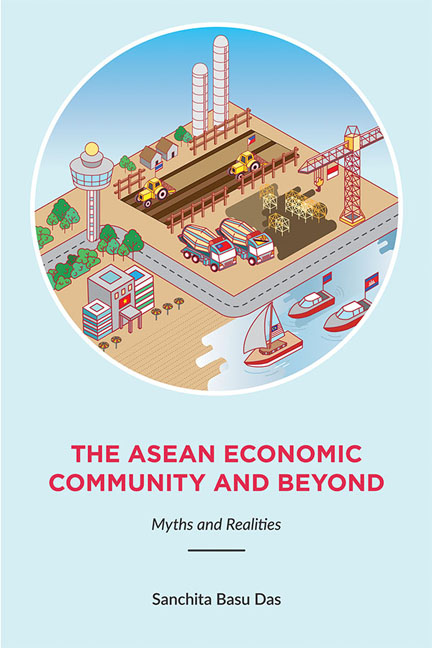Book contents
- Frontmatter
- Dedication
- Contents
- Foreword
- Acknowledgements
- Abbreviations
- 1 Introduction: The ASEAN Economic Community and Beyond
- I THE ASEAN ECONOMIC COMMUNITY (AEC)
- 2 The ASEAN Economic Community: An Economic and Strategic Project
- 3 Can the ASEAN Economic Community Be Achieved by 2015?
- 4 Goods to Flow Slow and Steady within the ASEAN Economic Community
- 5 The Limited Impact of the ASEAN Economic Community on Skilled Labour Migration
- 6 Five Facts About the ASEAN Economic Community
- 7 Growing Economic Diplomacy in ASEAN: Opportunities and Threats
- 8 Towards ASEAN Economic Community 2025!
- II BEYOND THE ASEAN ECONOMIC COMMUNITY
- III AN ASEAN PERSPECTIVE OF REGIONAL CONNECTIVITY
- Appendix: Summary of the Trans-pacific Partnership Agreement
- Index
- About the Author
8 - Towards ASEAN Economic Community 2025!
from I - THE ASEAN ECONOMIC COMMUNITY (AEC)
Published online by Cambridge University Press: 19 May 2017
- Frontmatter
- Dedication
- Contents
- Foreword
- Acknowledgements
- Abbreviations
- 1 Introduction: The ASEAN Economic Community and Beyond
- I THE ASEAN ECONOMIC COMMUNITY (AEC)
- 2 The ASEAN Economic Community: An Economic and Strategic Project
- 3 Can the ASEAN Economic Community Be Achieved by 2015?
- 4 Goods to Flow Slow and Steady within the ASEAN Economic Community
- 5 The Limited Impact of the ASEAN Economic Community on Skilled Labour Migration
- 6 Five Facts About the ASEAN Economic Community
- 7 Growing Economic Diplomacy in ASEAN: Opportunities and Threats
- 8 Towards ASEAN Economic Community 2025!
- II BEYOND THE ASEAN ECONOMIC COMMUNITY
- III AN ASEAN PERSPECTIVE OF REGIONAL CONNECTIVITY
- Appendix: Summary of the Trans-pacific Partnership Agreement
- Index
- About the Author
Summary
ASEAN will require a new economic community vision beyond 2015, given the changing nature of the region's political economic landscape. Such a new vision, suggestively called AEC 2025, needs to be based on ASEAN's own strengths and weaknesses. The present slowdown in the United States and the EU markets, growing competition from China and possibly India will convince ASEAN to hasten economic cooperation among its members. This will offer opportunities for foreign investors. AEC 2025 should aim for an economically desirable, politically acceptable and developmentally achievable region. It should aspire to increase productivity, enhance connectivity, liberalize services sector, give due attention to the PPP model of regional investment, deepen financial sector cooperation and seek new FTA partners. The new vision needs to address cross-cutting issues such as good governance, stronger institutions, and a transparent economic scorecard. In delivering on its promises by 2025, ASEAN should be able to build up on its credibility and maintain its centrality in the FTA structure of the Asia-Pacific in the long run.
INTRODUCTION
As ASEAN moves closer to 2015 in its bid to build an economic community as envisioned in its 2007 Blueprint, there will be increasing discussions about the organization's possibilities beyond that crucial year. Should ASEAN have a second regional economic vision that builds on its earlier efforts? The answer is a definitive “yes”. This is because building a community is an ongoing process in which new agreements and declarations will be needed in light of global political and economic changes. Moreover, ASEAN countries are at different developmental stages, meaning that the deepening of economic cooperation will require a judicious but steady approach.
What can a new AEC Vision look like? To start answering this question, we have to focus on ASEAN's strengths and weaknesses. At the same time, opportunities and threats after 2015 need to be recognized.
STRENGTHS AND WEAKNESSES
ASEAN is a growing market of 600 million people with a combined GDP of US$2.1 trillion. The region's robust economic growth is primarily driven by its demographic dividend fuelling domestic consumption, as well as investments in productive sectors. These factors suggest confidence among international investors in ASEAN's economic prospects. The countries’ strengths range from natural resource-based production to highly capitalintensive industries (electronics, textiles, automotive sector).
- Type
- Chapter
- Information
- The ASEAN Economic Community and BeyondMyths and Realities, pp. 82 - 92Publisher: ISEAS–Yusof Ishak InstitutePrint publication year: 2015

